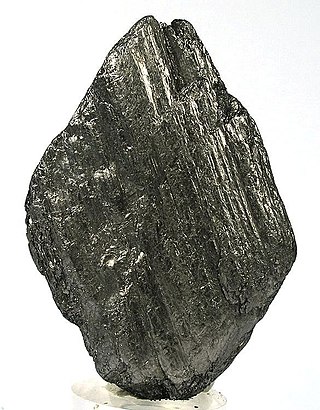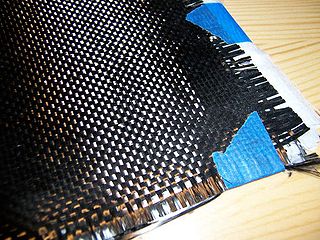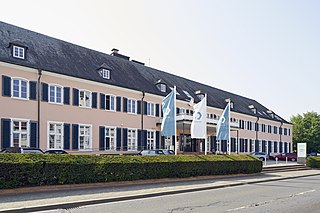
Boron nitride is a thermally and chemically resistant refractory compound of boron and nitrogen with the chemical formula BN. It exists in various crystalline forms that are isoelectronic to a similarly structured carbon lattice. The hexagonal form corresponding to graphite is the most stable and soft among BN polymorphs, and is therefore used as a lubricant and an additive to cosmetic products. The cubic variety analogous to diamond is called c-BN; it is softer than diamond, but its thermal and chemical stability is superior. The rare wurtzite BN modification is similar to lonsdaleite but slightly softer than the cubic form.

Graphite is a crystalline form of the element carbon. It consists of stacked layers of graphene. Graphite occurs naturally and is the most stable form of carbon under standard conditions. Synthetic and natural graphite are consumed on a large scale for uses in pencils, lubricants, and electrodes. Under high pressures and temperatures it converts to diamond. It is a good conductor of both heat and electricity.

The Bessemer process was the first inexpensive industrial process for the mass production of steel from molten pig iron before the development of the open hearth furnace. The key principle is removal of impurities from the iron by oxidation with air being blown through the molten iron. The oxidation also raises the temperature of the iron mass and keeps it molten.

Carbon fibers or carbon fibres are fibers about 5 to 10 micrometers (0.00020–0.00039 in) in diameter and composed mostly of carbon atoms. Carbon fibers have several advantages: high stiffness, high tensile strength, high strength to weight ratio, high chemical resistance, high-temperature tolerance, and low thermal expansion. These properties have made carbon fiber very popular in aerospace, civil engineering, military, motorsports, and other competition sports. However, they are relatively expensive compared to similar fibers, such as glass fiber, basalt fibers, or plastic fibers.

A crucible is a ceramic or metal container in which metals or other substances may be melted or subjected to very high temperatures. Although crucibles have historically tended to be made out of clay, they can be made from any material that withstands temperatures high enough to melt or otherwise alter its contents.

Silicon carbide (SiC), also known as carborundum, is a hard chemical compound containing silicon and carbon. A semiconductor, it occurs in nature as the extremely rare mineral moissanite, but has been mass-produced as a powder and crystal since 1893 for use as an abrasive. Grains of silicon carbide can be bonded together by sintering to form very hard ceramics that are widely used in applications requiring high endurance, such as car brakes, car clutches and ceramic plates in bulletproof vests. Large single crystals of silicon carbide can be grown by the Lely method and they can be cut into gems known as synthetic moissanite.

Crucible steel is steel made by melting pig iron, iron, and sometimes steel, often along with sand, glass, ashes, and other fluxes, in a crucible. In ancient times steel and iron were impossible to melt using charcoal or coal fires, which could not produce temperatures high enough. However, pig iron, having a higher carbon content and thus a lower melting point, could be melted, and by soaking wrought iron or steel in the liquid pig-iron for a long time, the carbon content of the pig iron could be reduced as it slowly diffused into the iron, turning both into steel. Crucible steel of this type was produced in South and Central Asia during the medieval era. This generally produced a very hard steel, but also a composite steel that was inhomogeneous, consisting of a very high-carbon steel and a lower-carbon steel. This often resulted in an intricate pattern when the steel was forged, filed or polished, with possibly the most well-known examples coming from the wootz steel used in Damascus swords. The steel was often much higher in carbon content and in quality in comparison with other methods of steel production of the time because of the use of fluxes. The steel was usually worked very little and at relatively low temperatures to avoid any decarburization, hot short crumbling, or excess diffusion of carbon; just enough hammering to form the shape of a sword. With a carbon content close to that of cast iron, it usually required no heat treatment after shaping other than air cooling to achieve the correct hardness, relying on composition alone. The higher-carbon steel provided a very hard edge, but the lower-carbon steel helped to increase the toughness, helping to decrease the chance of chipping, cracking, or breaking.

In materials science, a refractory is a material that is resistant to decomposition by heat or chemical attack that retains its strength and rigidity at high temperatures. They are inorganic, non-metallic compounds that may be porous or non-porous, and their crystallinity varies widely: they may be crystalline, polycrystalline, amorphous, or composite. They are typically composed of oxides, carbides or nitrides of the following elements: silicon, aluminium, magnesium, calcium, boron, chromium and zirconium. Many refractories are ceramics, but some such as graphite are not, and some ceramics such as clay pottery are not considered refractory. Refractories are distinguished from the refractory metals, which are elemental metals and their alloys that have high melting temperatures.

Vesuvius plc is a British engineered ceramics company headquartered in London whose products are used by steelmakers and foundries as well as in the glass and solar energy industries. The company is listed on the London Stock Exchange and is a constituent of the FTSE 250 Index.

An electric arc furnace (EAF) is a furnace that heats material by means of an electric arc.

Norton is a village in the Wychavon district of Worcestershire, 0.8 miles (1.3 km) from the boundary of the City of Worcester, England. The village sits within the Norton Juxta Kempsey civil parish and is split in two by the M5 motorway, with the original village to the east.

Showa Denko K. K., founded in 1939 by the merger of Nihon Electrical Industries and Showa Fertilizers, both established by a Japanese entrepreneur Nobuteru Mori, is a Japanese chemical company producing chemical products and industrial materials.
Joseph Dixon (1799–1869) was an inventor, entrepreneur and the founder of what became the Dixon Ticonderoga Company, a well-known manufacturer of pencils in the United States.

SGL Carbon SE is a European company based in Germany. It is one of the world's leading manufacturers of products from carbon.

Exothermic welding, also known as exothermic bonding, thermite welding (TW), and thermit welding, is a welding process that employs molten metal to permanently join the conductors. The process employs an exothermic reaction of a thermite composition to heat the metal, and requires no external source of heat or current. The chemical reaction that produces the heat is an aluminothermic reaction between aluminium powder and a metal oxide.
Sir Walter Vaughan Morgan, 1st Baronet, was a British businessman and the 578th Lord Mayor of London.

CoorsTek, Inc. is a privately owned manufacturer of technical ceramics for aerospace, automotive, chemical, electronics, medical, metallurgical, oil and gas, semiconductor and many other industries. CoorsTek headquarters and primary factories are located in Golden, Colorado, US. The company is wholly owned by Keystone Holdings LLC, a trust of the Coors family. John K. Coors, a great-grandson of founder and brewing magnate Adolph Coors Sr., and the fifth and youngest son of longtime chairman and president Joseph Coors, retired as president and chairman in January 2020 after 22 years at the helm.

Murugappa Group is an Indian conglomerate founded in 1900 by A. M. Murugappa Chettiar. The Group has 29 businesses including 10 companies listed on the NSE and the BSE. Headquartered in Chennai, the major companies of the Group include Carborundum Universal, Cholamandalam Financial Holdings, Cholamandalam Investment and Finance, Cholamandalam MS General Insurance, Coromandel International, EID Parry, Parry Agro Industries, Shanthi Gears, Tube Investments of India, Wendt (India), and CG Power and Industrial Solutions.

Carborundum Universal Ltd (CUMI) is an Indian company which manufactures and develops abrasives, ceramics, refractories, aluminium oxide grains, machine tools, polymers, adhesives and electro minerals in India. It is a part of Murugappa Group.
















